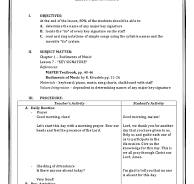
The Importance of Music in Education
Music is an essential part of a well-rounded education, offering numerous benefits for students of all ages. Incorporating music into lesson plans can enhance learning across various subjects and foster creativity, critical thinking, and emotional expression.
Benefits of Including Music in Lesson Plans:
- Enhanced Learning: Studies have shown that music can improve memory retention and cognitive skills, leading to better academic performance.
- Creativity: Engaging with music encourages students to think outside the box and express themselves in new ways.
- Cultural Understanding: Exploring different types of music exposes students to diverse cultures and traditions, promoting empathy and global awareness.
- Emotional Development: Music has the power to evoke emotions and can be a valuable tool for teaching empathy and emotional intelligence.
Sample Music Lesson Plan:
Title: Exploring Rhythms Around the World
- Objective: To introduce students to different rhythmic patterns from various cultures.
- Materials Needed: Percussion instruments (drums, shakers, etc.), recordings of traditional music from different countries.
- Activities:
- Listen to examples of rhythmic patterns from different cultures and discuss their unique qualities.
- Experiment with creating rhythms using percussion instruments.
- Create a collaborative composition incorporating elements from multiple cultural traditions.
- Evaluation: Assess students based on their participation in discussions, creativity in rhythm creation, and teamwork during the composition exercise.
In conclusion, integrating music into lesson plans can enrich the educational experience for students and provide valuable learning opportunities beyond traditional subjects. By recognizing the importance of music in education, teachers can inspire a lifelong appreciation for the arts and foster holistic development in their students.
Essential Guide to Crafting and Teaching Effective Music Lesson Plans
- How to write a lesson plan for music?
- What are the 4 methods of teaching music?
- How do you teach music lessons?
- How to teach a song lesson plan?
How to write a lesson plan for music?
Creating a lesson plan for music involves careful consideration of the learning objectives, activities, materials, and assessment methods. To begin, identify the specific musical concepts or skills you want to teach and tailor your plan accordingly. Start with an engaging introduction to capture students’ interest and provide context for the lesson. Incorporate a variety of activities such as listening exercises, hands-on instrument practice, and group collaborations to cater to different learning styles. Select appropriate music resources and materials to support your lesson content effectively. Finally, evaluate student understanding through assessments that align with the learning objectives. By following these steps and incorporating creativity and flexibility into your lesson plan, you can create a rewarding and impactful music education experience for your students.
What are the 4 methods of teaching music?
When it comes to teaching music, there are four primary methods that educators often employ to engage students effectively. The first method is the Orff approach, which emphasizes hands-on learning through the use of percussion instruments and movement. The Kodály method focuses on developing musical skills through singing and ear training, promoting a strong foundation in music theory. Another popular method is the Dalcroze approach, which incorporates movement and improvisation to enhance students’ understanding of rhythm and musical expression. Lastly, the Suzuki method centers around learning music by ear and fostering a supportive learning environment to nurture musical talent. Each of these methods offers unique benefits and can cater to different learning styles, providing diverse opportunities for students to explore and appreciate the world of music.
How do you teach music lessons?
When teaching music lessons, it is essential to create a well-structured and engaging plan that caters to the needs and interests of the students. Incorporating a variety of teaching methods, such as listening exercises, hands-on activities, and group collaborations, can help make the learning experience dynamic and interactive. Providing clear instructions, demonstrating techniques, and offering constructive feedback are also crucial aspects of effective music instruction. Additionally, fostering a supportive and encouraging environment where students feel comfortable exploring their musical abilities can enhance their learning outcomes and overall enjoyment of the lessons. By tailoring lesson plans to accommodate different learning styles and abilities, educators can create a positive and enriching music education experience for their students.
How to teach a song lesson plan?
Teaching a song lesson plan involves a structured approach to incorporating music into the classroom. To effectively teach a song, start by selecting a song that aligns with the learning objectives of the lesson. Break down the lyrics and melody to ensure students understand the content and rhythm. Introduce vocabulary or cultural context related to the song to enhance comprehension. Encourage active participation by having students sing along, analyze the lyrics, or create their own interpretations of the song. Consider incorporating activities like group singing, musical games, or discussions about the themes of the song to engage students and deepen their understanding. By following these steps and adapting them to suit your students’ needs and interests, you can create a dynamic and enriching song lesson plan that fosters creativity, cultural awareness, and a love for music in your classroom.
